Ironman Athlete Overcomes Bike Crash and Blood Clots
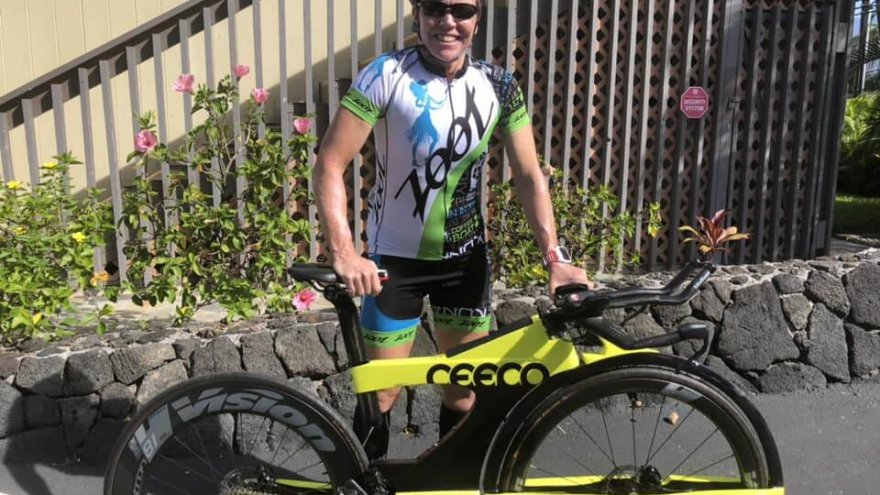
To see Tina Eakin ride past you on her triathlon bike, you would find it hard to conceive that nearly one year ago, she was lying in the hospital with a fractured acetabular. An acetabular fracture is a break in the socket portion of the ball-and-socket hip joint, and it often requires surgery.
Not the diagnosis an athlete who is just three months away from competing in the Ironman World Championships in Kailua-Kona, HI wants to receive. But that’s just the diagnosis Tina was facing after an easy group bike ride went dangerously wrong.
The Bike Crash
An Ironman finisher who has been racing triathlons since finishing her first one on Oahu in 1999, Tina has qualified for the Ironman World Championships multiple times. After qualifying at the 2018 Ironman 70.3 Santa Rosa, a half-iron triathlon in CA, Tina was on her way to the Championships for the sixth time.
Tina’s training for Ironman Worlds would include several shorter races before the big day, including the June Lake Long Course Half-Ironman triathlon in July. Tina confirms that the rumors about June Lake are merited – The run is tough, but Tina was tougher.
“I did June Lake and I was feeling good.”
Her performance at June Lake was the boost of confidence that Tina needed, assuring her that her fitness was where it needed to be for her to have a successful day at the World Championships.
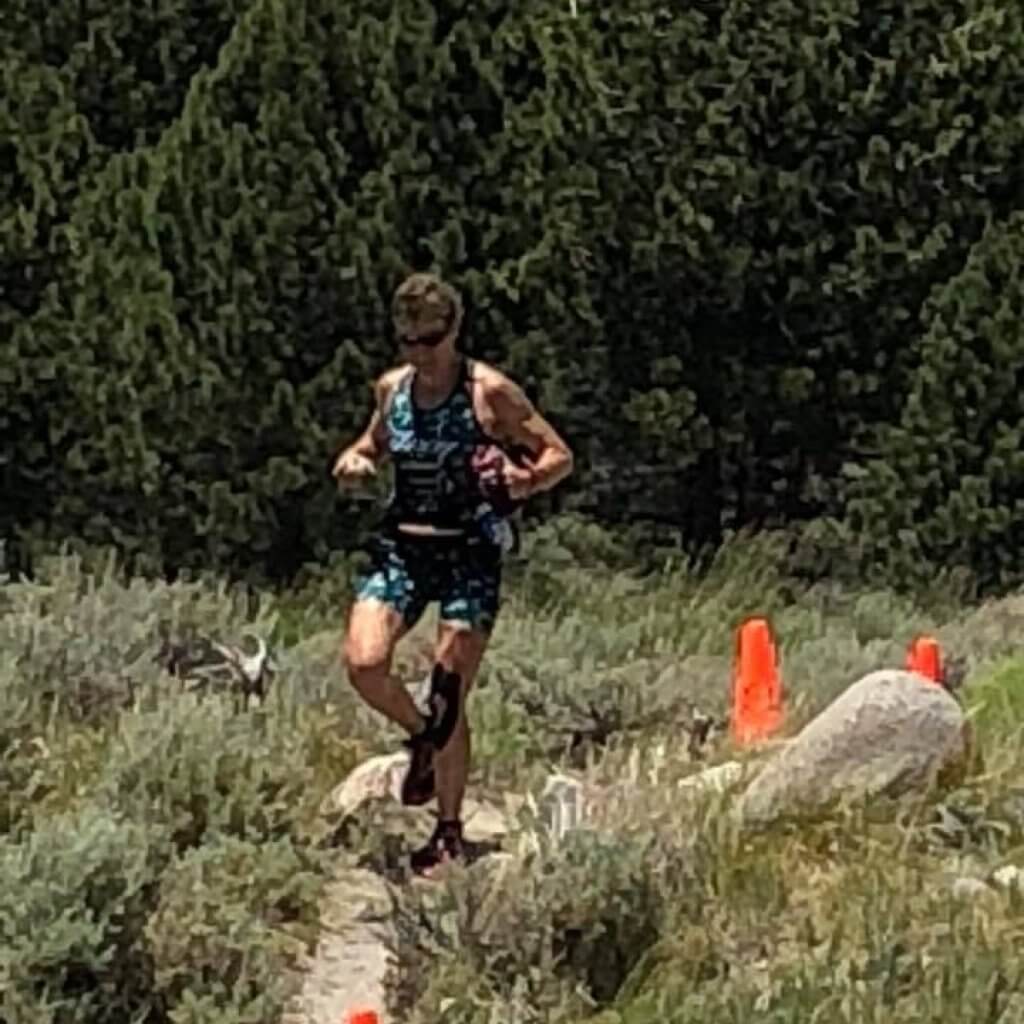
On July 12th, Tina headed out for a group ride. The easy ride would be an ideal way to get some miles in to prepare for Ironman and actively recover from the June Lake race she had done three days prior. As Tina descended a slight hill with the group, the rider in front of her caught the wheel of the bike in front of him causing him to crash, and Tina’s bike had nowhere to go but down with him.
After 20 hours in the ER, Tina was informed that her acetabular was broken, but she would not need surgery on her hip since she had a stable fracture. As surgery often results in a limited range of motion and therefore limited activity after the operation, this was incredible news!
“I am blessed that I didn’t have to have surgery!” she exclaims. For Tina, surgery would likely equate to retirement from racing Ironman.
But a return to sport was still on the distant horizon, as Tina now faced something more serious than a stable fracture.
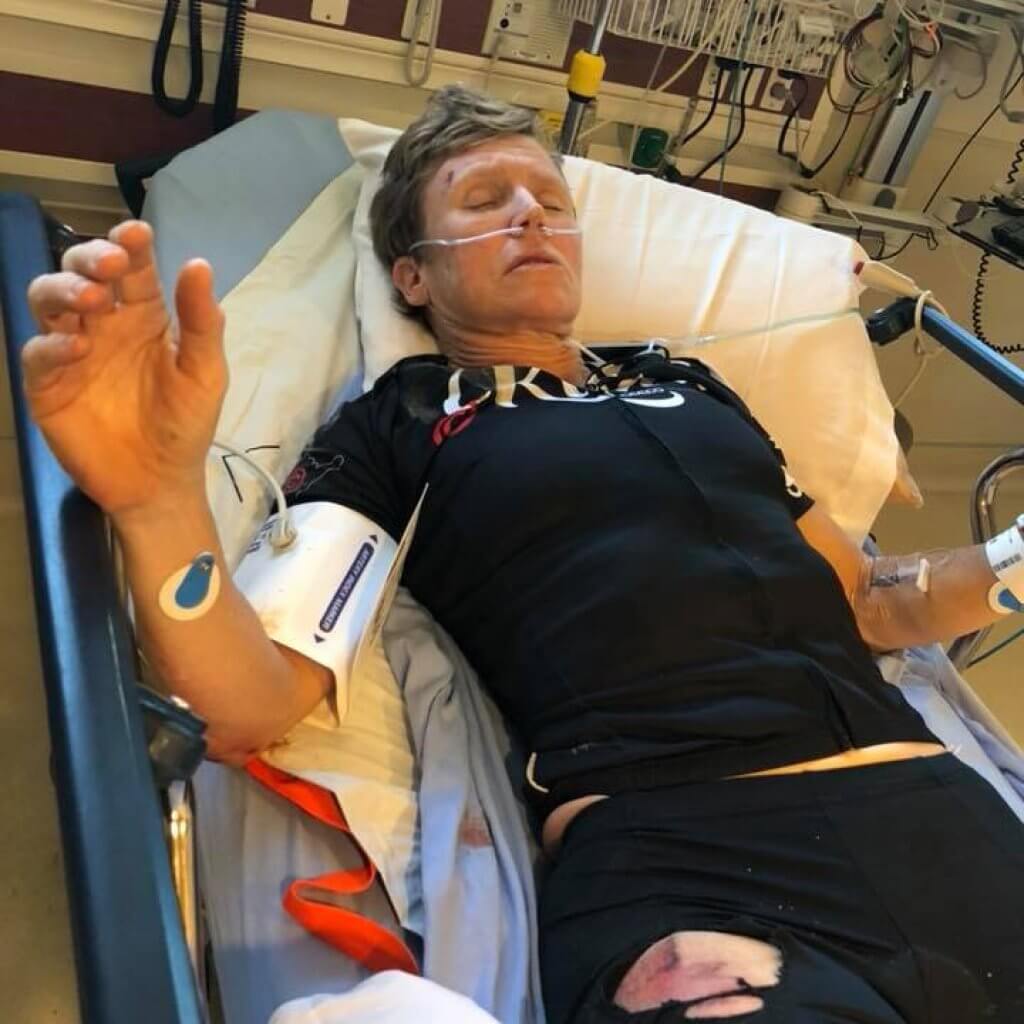
The Blood Clots
Because of inactivity during and after surgery, Tina was at risk for developing a blood clot known as deep vein thrombosis (DVT).
“I got chest pain and didn’t think anything of it at first. But it was on my left side and it got worse at night,” says Tina. One week after getting home from the hospital, she was back.
When Tina told the physicians at the ER about the pain in her chest, the obvious assumption was that she had a fractured rib from her bike crash. A CT scan revealed a more dire condition though. Tina had a pulmonary embolism (PE) from a DVT in her calf that had broken off and traveled to her lungs.
Coagulation, or blood clot formation, is the body’s normal response to certain injuries. When you get a cut, healthy clots form at the skin’s surface.
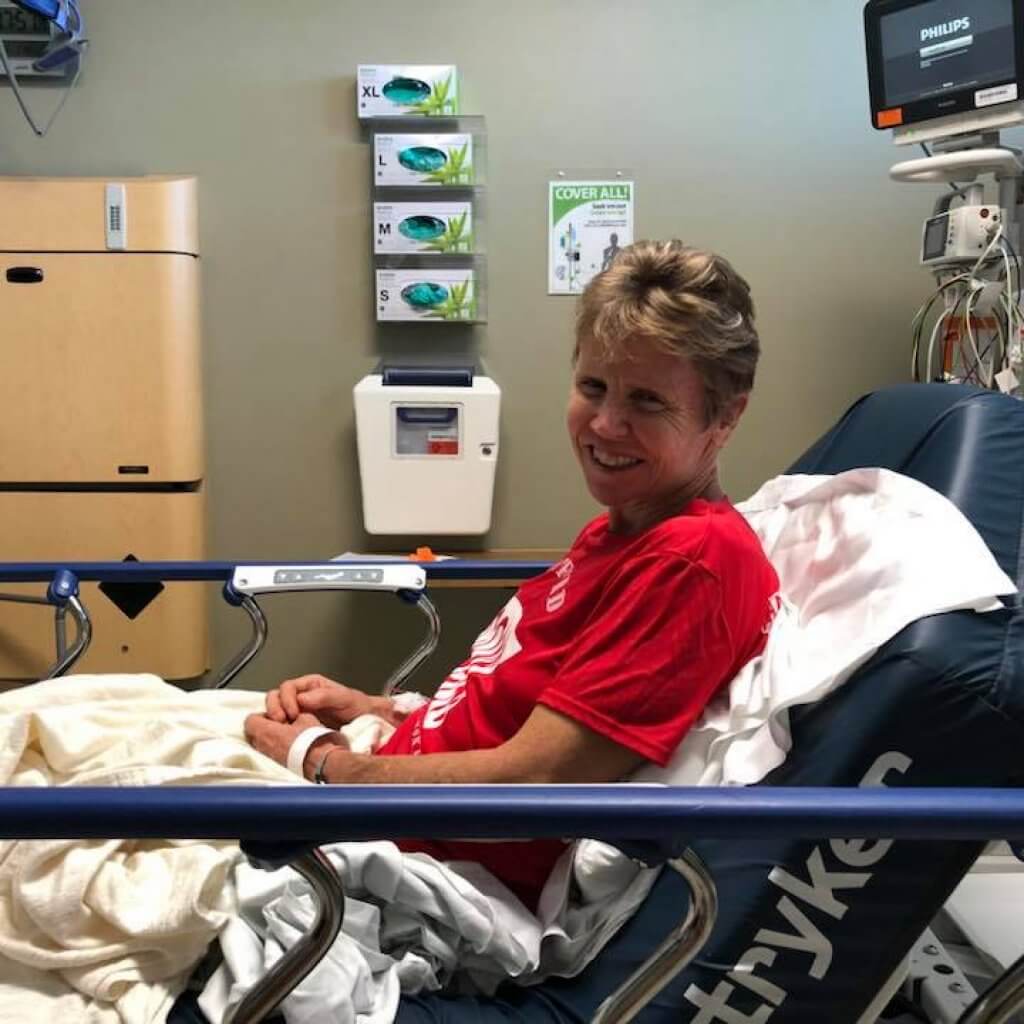
But a clot occasionally forms inside the blood vessels, which can be life-threatening. Unfortunately, this is how Tina’s body reacted to her injury and consequent inactivity.
She was immediately put on anticoagulants, or chemical blood thinners. For an entire four months, Tina was on these anticoagulants to prevent more clots from forming while her body worked to dissolve the existing clots.
It took her body one month to dissolve the pulmonary embolism, and three months to dissolve the deep vein thrombosis. During that time, training was nearly impossible due to the immense fatigue that blood clots cause.
So how does someone who has been an endurance athlete for two decades cope with not being able to work out?
“To cope I tried meditation,” Tina offers. “But running is really my meditation, so this was not the same. What really got me through was support from my friends and family. I had amazing support from wife Teresa and my best friend Jack.”
The First Ride
The first ride Tina was able to attempt happened one month after her crash.
“I started riding on the recumbent bike and I was only able to ride for a whopping 12 minutes,” says the woman who was accustomed to riding her tri bike for five hours and 40 minutes when she raced Ironman.
“I could have just cried thinking about where I used to be and where I was, too exhausted to ride for more than 12 minutes.”
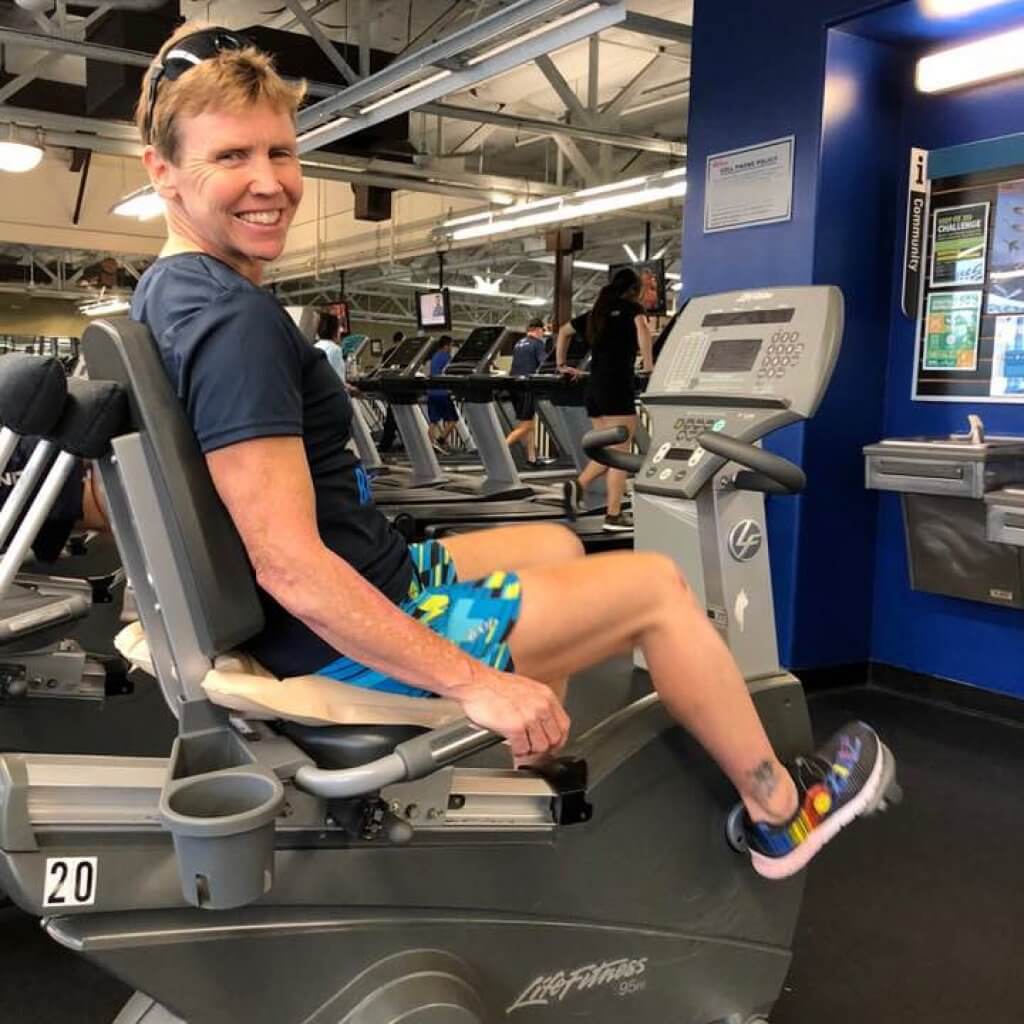
Tina was tired, discouraged, and traumatized by the bike crash and blood clots. But 8 weeks after her accident, she showed up for her first physical therapy appointment anyway. And sometimes, simply showing up can change everything!
Fighting the exhaustion, Tina lifted weights while still on crutches. She used the arm bicycle machine for 10 minutes at a time until her body allowed her to continue for longer.
Fatigue wasn’t the only obstacle Tina had to overcome. A comparison was also a challenge for the 11-time Ironman World’s finisher.
“My coach, Joanna Zieger, would constantly remind me to look at my progress,” Tina affirms. “I had to be intentional about not comparing myself to where I used to be before the accident!”
Tina spent the rest of the summer on the upright stationary bike, and by September she graduated to riding her bike on the trainer. Not long after that, Tina got back in the water again.
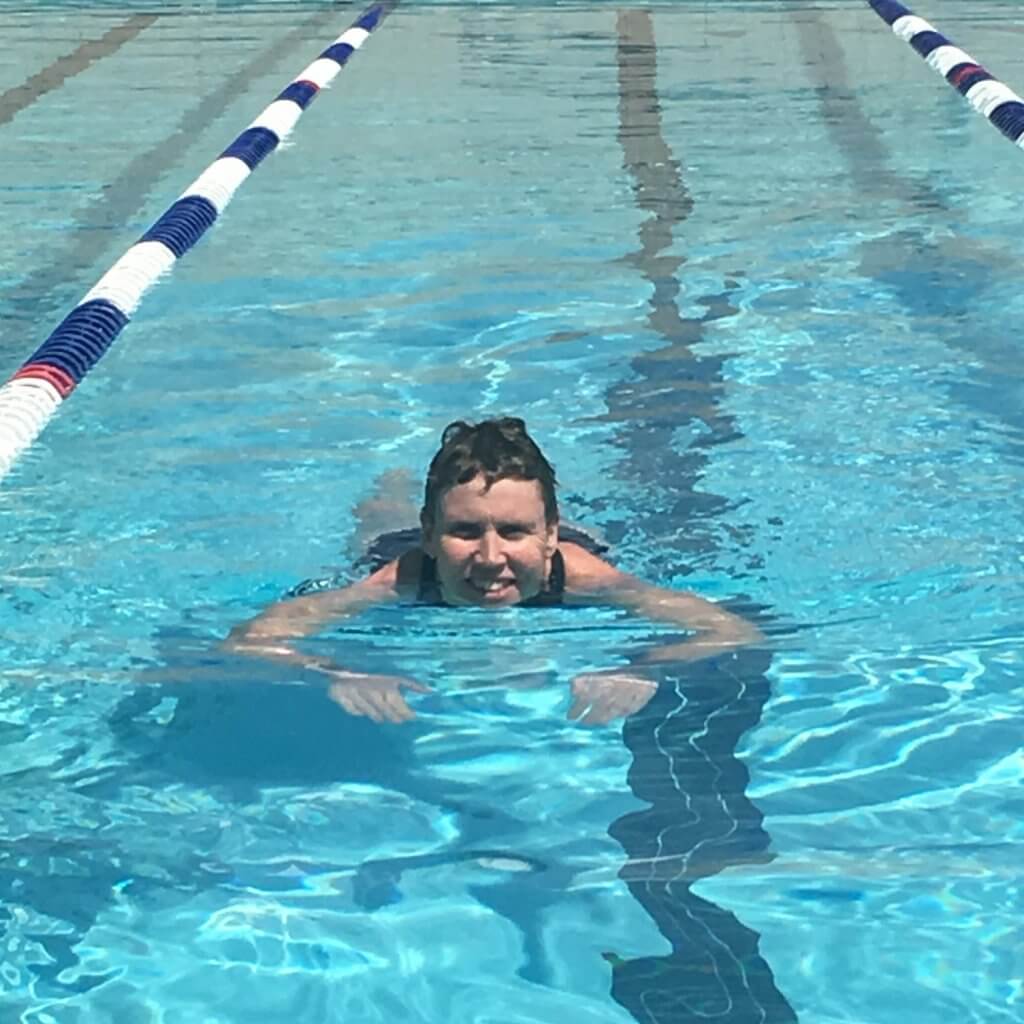
Although still exhausted, and unable to kick, Tina began to swim again using a pull buoy. Her first actual ride outside after the accident wouldn’t happen until the week of the very Ironman World Championships that she had been training for until her bike crash.
“We had all our arrangements made for our trip to Hawai’i Island for Ironman Worlds, so we went despite the fact that I couldn’t race,” Tina recalls. “That’s where I did my first official ride after the accident.” When she arrived in Kona, she was welcomed warmly by her fellow athletes and sponsors.
“Even though I couldn’t race Ironman, Ceepo gave me a tri bike to use while I was in town and Team Zoot really stuck with me as their age group sponsored athlete!” Tina says of her gratitude for the sponsors that had her back during her recovery.
Tina served in the Navy for 15 years and then transferred to the Army, serving collectively for 22 years and retiring in 2014. During that time, she was fortunate enough to serve without encountering anything traumatic. After the accident, and more specifically the blood clot, Tina did show signs of what she describes as moderate post-traumatic stress disorder (PTSD) however.
“I was afraid that I was getting another blood clot. I was scared to get back on the bike again,” she confirms.
Tina’s fears were not unfounded. Still on blood thinners when she went for her first ride outside on an actual triathlon bike, Tina was aware that having blood clots once would increase her risk for more to develop.
“I knew to fall would be really bad, but I made myself get back out there,” she acknowledges. “I didn’t ride with groups for a while. But I got out there because I’m not going to stop riding!”
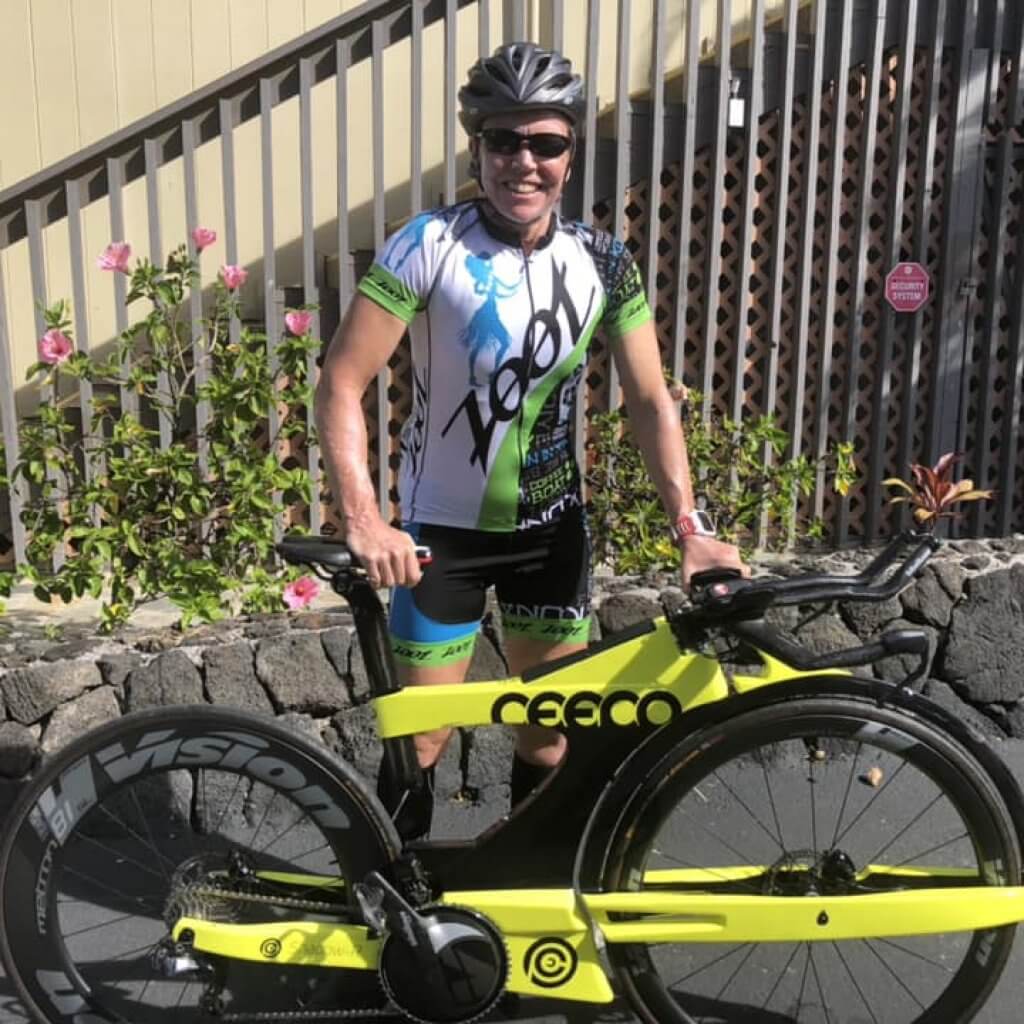
It was also there in Kona, bolstered by the support of the triathlon community, that Tina finally began running again.
The Return to World Championships
Until March of this year, Tina’s return to true racing was hardly a sure thing. Instead, her focus was on healing and building her strength and endurance back up.
“But I always knew in my heart that I would get back out there,” Tina acknowledges when asked about racing Ironman again. “I was scared, sure, but I am determined!”
So upon receiving an invitation to race the Ironman 70.3 Hawai’i triathlon on Hawai’i Island in June, Tina accepted. Still low on energy, Tina was also experiencing difficulty breathing, so she didn’t arrive in Hawai’i with high expectations, let alone plans of qualifying for Ironman Worlds.
“I was even saying that I didn’t think I could do it because I would get so frustrated with the breathing,” says Tina, referring to another unwelcome result of the blood clots, vocal cord dysfunction. Vocal cord dysfunction (VCD) is the dysfunctional movement of the vocal cords, causing airway obstruction and symptoms including wheezing, a cough, and a general feeling of not being able to get a deep breath.
“But I just kept moving forward,” Tina asserts. “I just put my heart into it and did the best I could!” And her best just happened to be good enough for second place in her age group and an entry into the 2019 Ironman World Championships.
Although it was a chance that Tina hoped to have again one day, racing Ironman Worlds wasn’t an opportunity that she anticipated having a mere one year after her bike crash and subsequent blood clots.
She wasn’t even planning to attend the awards ceremony to find out if she had qualified for Worlds, “But Teresa made me sit through them to find out if I had the Championships slot. I did! And I believe it was meant to be!”
“She is the best sherpa out there!” Tina declares. “I am so thankful for my wife and all the support she gave me through a horrible time!”
They say that finishing an Ironman takes a village. Tina is proof that nobody gets to the Ironman start line on their own either!
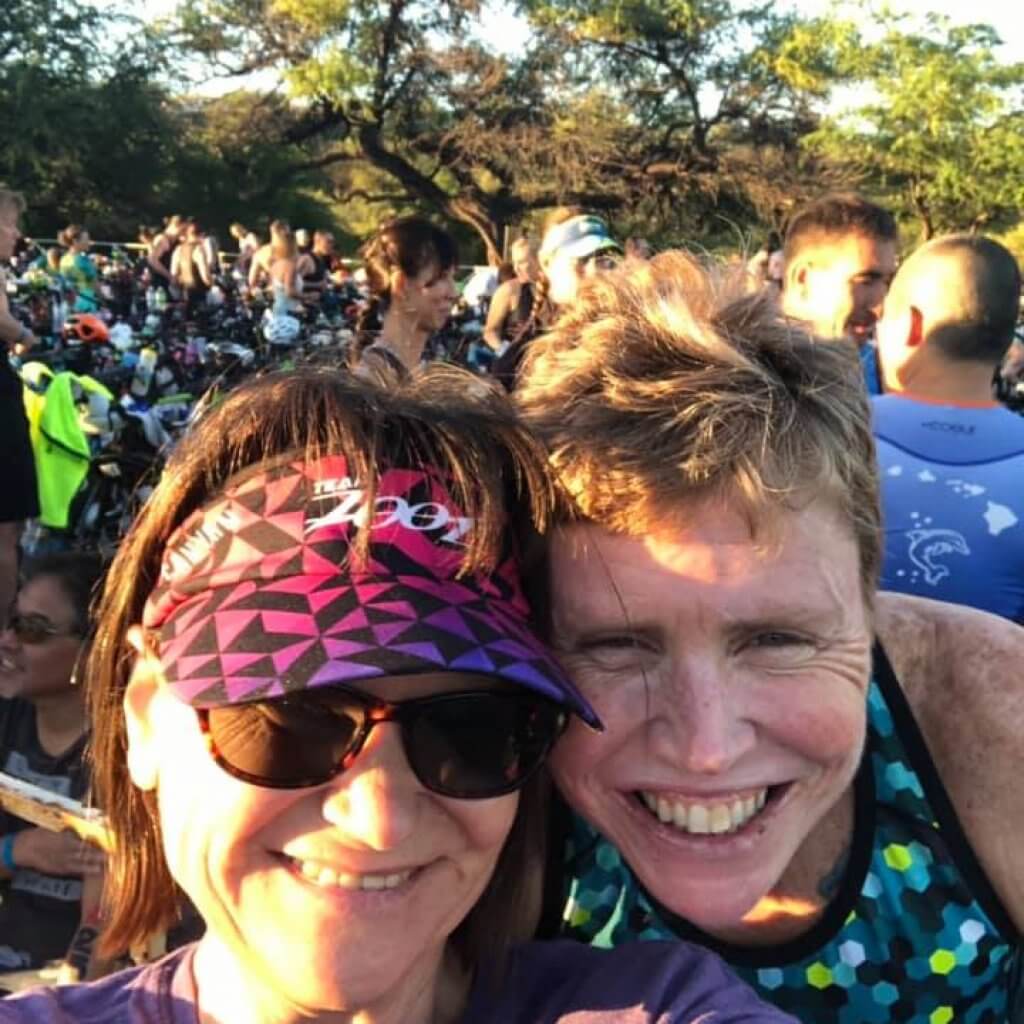
The Risk and Prevention of Blood Clots in Athletes
Arteries are the blood vessels that carry blood from the heart into the arms, the legs, the brain, and the internal organs. Clots in our arteries can result in heart attacks, stroke, or limb-threatening peripheral arterial clots.
“Endurance athletes are prone to blood clots,” Tina cautions. “And many of us don’t learn anything about the risks or how to prevent clots until we’re in the ER.”
Don’t assume that blood clots are a problem that occurs in the elderly, as opposed to healthy, active individuals. There are several reasons that athletes are at increased risk for DVT and PE, such as bone fractures or major surgery, immobilization after an accident or surgery, dehydration during and after intense exercise, and traveling long distances to and from a race (by bus, plane, or car).
Endurance athletes who run marathons, bike hundreds of miles, or compete in long-distance triathlons can have a lower-than-average heart rate and blood pressure, which are both risk factors for blood clotting.
Keep an eye out for the signs and symptoms of DVT, including a leg that is warm and bluish or reddish, cramping that ice or stretching don’t treat, swelling in one of your legs, or tenderness and pain in your leg.
The symptoms of pulmonary embolism include a racing heart rate, cramps in your chest or side, a fever, shortness of breath or inability to catch your breath, unexplained cough or coughing up blood or feeling faint, dizzy, or unexplainably fatigued.
“Know the prevention. Know the symptoms!” Tina pleads. As she learned, athletes with DVT need to refrain from training for a minimum of a month so the blood clot has time to dissolve.
Often, athletes will be put on a blood thinner as Tina was, and should, therefore, avoid high-intensity sports, contact sports, group swims, and cycling. It’s critical that an athlete on blood thinners is incredibly careful not to fall if running or hiking.
To prevent blood clots in the first place, find out whether you have a family history of blood clotting. Ask your doctor whether you need DVT prophylaxis after experiencing major surgery, trauma, prolonged immobility, or being in a cast.
“Whether it’s ultra running or Ironman, wear compression socks. If you have to travel long distances for a race, take breaks and stretch your legs a lot,” advices Tina, who has done significant research on blood clotting after suffering from it herself. “Get up and move around periodically, and avoid sitting for too long.”
During and after travel, a strenuous workout, or a race be intentional about staying hydrated. Additionally, limit alcohol and caffeine consumption, which have a diuretic effect and can contribute to dehydration.
Listen to your body! And seek medical attention immediately if you suspect PE, as this condition could be fatal.
Don’t make the mistake of assuming that pain in your leg is simply a pulled muscle. If the pain persists or occurs in conjunction with the symptoms listed above, contact your doctor.
For more information on athletes and blood clots, visit www.stoptheclot.org/about-clots/athletes-and-blood-clots.
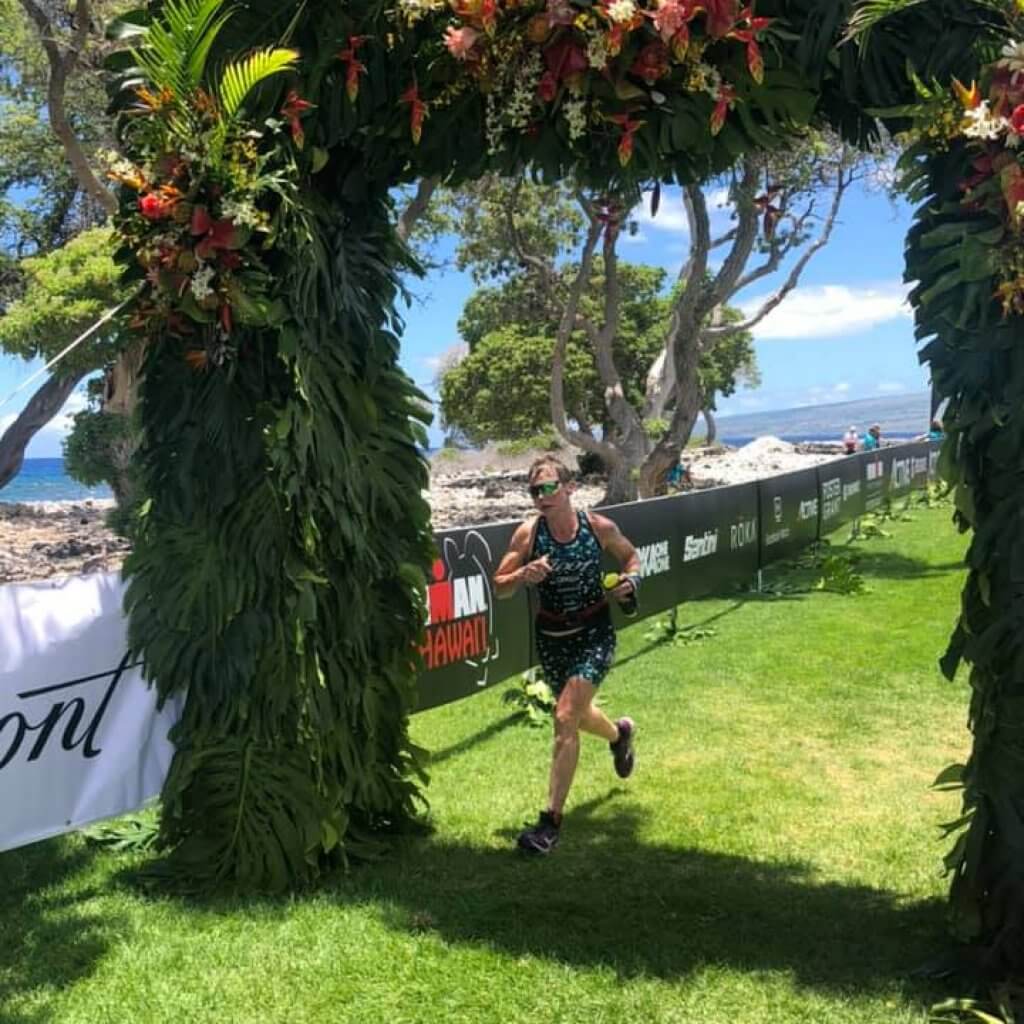
Tina will turn 49 in August. In October, she will toe the line of the Ironman World Championships for the sixth time. But this time will be remarkably different.
“Will the World Championships be different this year? Definitely! Because I’ve had to overcome a lot more to get to this one!”
“The start line of an Ironman is always terrifying!” Tina replies when asked if racing is a bit more unnerving after her accident. “You never know what could happen! But the start line is my victory!”
Follow Tina and her Ironman comeback on www.facebook.com/tina.l.eakin
Latest Articles
 Is Running on a Treadmill Easier Than Running Outside?Runners have their own preferences, whether it is treadmill running, running outside on the road, or exploring trails. So...
Is Running on a Treadmill Easier Than Running Outside?Runners have their own preferences, whether it is treadmill running, running outside on the road, or exploring trails. So... Is It OK to Use Trail Running Shoes on the Road?While trail running shoes can be used on roads, especially in situations where a runner encounters mixed terrains or pref...
Is It OK to Use Trail Running Shoes on the Road?While trail running shoes can be used on roads, especially in situations where a runner encounters mixed terrains or pref... How to Fix Sore Quads After Running?Rest, ice, gentle stretching, and over-the-counter pain relievers can help soothe sore quads after running. Also, ensure ...
How to Fix Sore Quads After Running?Rest, ice, gentle stretching, and over-the-counter pain relievers can help soothe sore quads after running. Also, ensure ... 10 Fruits With The Most Electrolytes to Replace Sports DrinksThese fruits are high in electrolytes such as potassium, magnesium, and calcium, essential for hydration, muscle function...
10 Fruits With The Most Electrolytes to Replace Sports DrinksThese fruits are high in electrolytes such as potassium, magnesium, and calcium, essential for hydration, muscle function...

